MRRL Hall of Fame
HANK BALLARD & THE MIDNIGHTERS
- Details
- Category: Inductees
- Created: Tuesday, 04 October 2011 09:57
- Written by Gary Johnson
Detroit was a hotbed of music in the early 50’s, and the city’s biggest recording act and the first to bridge the gap from Rhythm and Blues into Rock and Roll was Hank Ballard & The Midnighters. Ballard and the group would also go on to record the original version of “The Twist” in 1958, the most successful dance tune in the history of Rock and Roll.
The group started out at Dunbar High School in Detroit as the Royals with lead singers Charles Sutton and Henry Booth, along with Lawson Smith, and Sonny Woods. Alonzo Tucker was the group’s arranger and guitarist.
The group’s big break came when they entered an amateur talent contest in November of 1951 at the Paradise Theater on Woodward Avenue. Orchestra leader Johnny Otis, who was riding a string of thirteen R&B hits during the past two years, was also a talent scout for King/Federal Records out of Cincinnati. The Royals were one of the acts that Otis recommended to King/Federal along with vocalists Little Willie John and Jackie Wilson.
Because vocal groups like the Orioles, the Clovers, the Five Keys, and the Dominoes were the hottest craze in R&B, John and Wilson were passed over and the Royals signed to the label. A Johnny Otis-penned ballad, “Every Beat Of My Heart” was chosen for the group’s first release on Federal, but the record didn’t sell outside of Detroit. The Royals’ next five singles failed as well.
When original member Lawson Smith left the group to enter the service, he was replaced by Hank Ballard. Hank was both a talented singer and songwriter who would move the Royals into a newer and more modern sound that would not only take them to the top of the R&B charts, but also help pave the way for Rock and Roll. Hank Ballard
Hank Ballard
Ballard was born in Detroit in 1927, but after the death of his parents in 1934, he was sent to live with his aunt and uncle in Bessemer, Alabama. There, he was exposed to two important influences; Gospel music through his singing in the church choir and Country music from the recordings of the “Singing Cowboy”, Gene Autry. But Ballard also loved the Blues shouting of Jimmy Rushing, and the crooning of Nat “King” Cole. He later said of his musical influences: “I’m a little Country; I’m a little R&B; I’m a little Pop; I’m a little Gospel; I’m a little bit of everything”.
According to David A. Carson’s book Grit, Noise, And Revolution, at the age of fifteen, Ballard ran away and returned to Detroit. He found work at the Ford plant and would sing the harmonies of popular songs to the rhythm of the assembly line. Sonny Woods of the Royals also worked there, and he invited Ballard to sing in several of the contests at the Paradise Theater. When Smith was drafted, Ballard was invited to join the Royals.
Hank felt the Royals needed to modernize their sound and get away from the syrupy ballads that had been their stock and trade. He had been writing songs for some time, and he pitched an upbeat song called “Get It” to both the group and label owner Syd Nathan who loved it. The recording of “Get It” featured Ballard singing lead, and it became the Royals first hit in 1953 when it reached # 6 on the R&B chart.
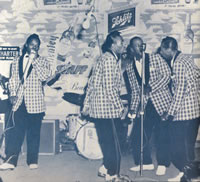 The Midnighters
The Midnighters
For the all-important follow-up, Ballard had written a song with the original title of “Sock It To Me Mary”. By the time it was finished, it had become the slightly less graphic, “Work With Me Annie”. Featuring the electric guitar of Alonzo Tucker, the song’s driving beat attracted both black and white listeners and topped the R&B charts for seven weeks and even reached # 22 on the Pop charts in the summer of 1954 despite getting virtually no airplay.
“Work With Me Annie” was banned from many radio stations because ‘work’ was slang in the black community for sex. Ballard later claimed that the real Annie was a girlfriend from Louisville, Kentucky, and that he was trying to woo her with the suggestive lyrics.
The overwhelming success of “Work With Me Annie” also led to a name change for the group. There was another successful R&B group called the “5” Royales recording for the Apollo label, so to avoid confusion, Ballard suggested that the Royals switch their name to the Midnighters. New pressings of the record now listed ‘The Midnighters (Formerly Known As The Royals)’ as the recording artist. 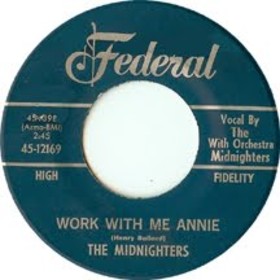
The Midnighters’ follow-up single was another uptempo recording with the somewhat naughty title of “Sexy Ways”. It peaked at # 2 on the R&B chart, but whether or not “Sexy Ways” could be considered an ‘answer record’ to “Work With Me Annie”, there were over 20 recordings issued in 1954-55 that jumped on the bandwagon. The most successful of these was “Roll With Me Henry” (for Hank Ballard) by Etta James with The Peaches. It reached # 1 on the R&B charts after its title was changed to “The Wallflower” to ensure radio play.
In light of the continued interest in “Annie”, Federal Records pressured the Midnighters to record a series of answer songs. The best of these was “Annie had A Baby” which reached # 1 on the R&B chart in late 1954. “Annie’s Aunt Fanny” and “Henry’s Got Flat Feet (Can’t Dance No More)” were minor chart hits. In the meantime, a white artist named Georgia Gibbs had a # 1 Pop hit when she covered the Etta James recording and changed its title to the more acceptable “Dance With Me Henry”.
By this time the Midnighters had become one of the hottest acts in R&B, headlining across the country. Ballard convinced group members to work out a series of choreographed dance moves to perform while he sang lead. Now led by influential guitarist Cal Green, they were also the first group to be self-contained with a band. Ballard recruited mostly jazz musicians for his backing band, employing a strategy that Berry Gordy would later use at Motown in order to find the musicians who could play what Ballard called “the funky thing”.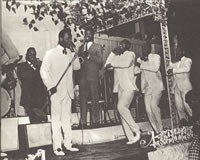 Hank Ballard and The Midnighters
Hank Ballard and The Midnighters
Despite their popularity on the R&B circuit, the Midnighters went over three years without a charting hit following “It’s Love Baby (24 Hours A Day)” in the summer of 1955. Even though the Midnighters released some classic sides like “Don’t Change Your Pretty Ways”, “Tore Up Over You”, “Open Up The Back Door”, and “Is Your Love For Real”, nothing caught on with the record-buying public until 1958.
During the group's dry spell. the Midnighters' line-up underwent a few changes. Lawson Smith, who had left the group after he had been drafted, returned from the U.S. armed forces and replaced Charles Sutton. Norman Thrasher replaced Sonny Woods, and guitarist Cal Green took the place of Arthur Porter, who had earlier replaced Alonzo Tucker. It was during this time of transition that Ballard wrote one of the most famous Rock and Roll songs of all time when he came up with “The Twist”. Hank based the melody on an old Drifters’ song, featuring Clyde McPhatter, called “What ‘Cha Gonna Do”.
The Midnighters recording contract with King/Federal had run out so “The Twist” was first recorded in the spring or early summer of 1958 in a Miami school auditorium. Shortly thereafter, the Midnighters' Cal Green was busted on a marijuana possession charge. His spot in the group was filled by J. C. "Billy" Davis, a talented teenaged guitarist from Detroit. 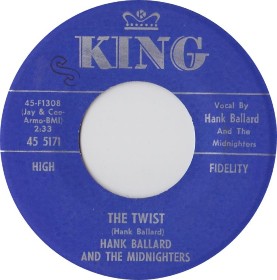
Ballard offered "The Twist" to several other labels before King/Federal decided to renew the group’s contract after hearing the unissued take. The Midnighters rerecorded the song with Davis on lead guitar, but the King label put “The Twist” out as the B-side of a bluesy ballad, “Teardrops On Your Letter”. The release of the single marked the first time that the group was billed as Hank Ballard & The Midnighters.
“Teardrops On Your Letter” returned the group to the charts as it peaked at # 4 on the R&B chart and also became a minor Pop hit at # 87. “The Twist” became a # 16 R&B hit as well. Years later in an interview Ballard remembered; “The company I was with didn’t have any faith in it. They thought "The Twist" was just a mediocre record. But Dick Clark and Chubby Checker made believers out of them”.
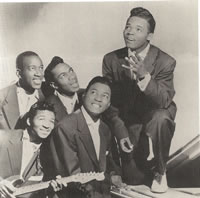
Hank Ballard & The Midnighters recording of “The Twist” was a very popular record at high school sock hops and in dance clubs, and it eventually came to the attention of Dick Clark. Clark was interested in having the group perform the song on American Bandstand but was uncomfortable with their reputation because of the “Annie” songs and their suggestive lyrics. According to Jim Dawson's book, The Twist, Dave Appell of Cameo-Parkway Records wanted to make a new recording of the song. Clark was part owner of the label at that time and made a deal with Syd Nathan of King Records to promote Hank Ballard & The Midnighters' next two singles ("Finger Poppin' Time" and "Let's Go, Let's Go, Let's Go") on American Bandstand in exchange for obtaining the licensing rights for "The Twist" for one of his Cameo-Parkway artists.
“The Twist” was then covered by Ernest Evans, a young singer with the stage name Chubby Checker. He performed it on American Bandstand in 1960 along with the dance moves first done on stage by the Midnighters. Checker was skilled at doing impressions, and he mimicked Hank Ballard’s vocal so closely that when Ballard first heard Chubby Checker’s version of “The Twist” on the radio, he thought it was his original recording.
Checker’s cover of the song holds the distinction of being the only single in the history of Rock and Roll to reach # 1 in two different years; first in 1960, and then again in 1962 after the single had been re-released. Even though Hank Ballard & The Midnighters didn’t have the biggest hit with the song, but their version of “The Twist” did become a popular hit when King re-released it in 1960 and it reached # 6 on the R&B chart and # 28 on the Billboard Hot 100.
1960 would prove to be the biggest year yet for Hank Ballard & The Midnighters. It started with a song idea that Hank got in a New York City bar. While there, he noticed a young lady who walked in and asked a patron what time is was. The guy replied “Oh baby, it’s finger poppin’ time”. Ballard went straight to his hotel and wrote the tune. “Finger Poppin’ Time” would become a # 2 R&B smash and also the group’s first Top Ten single on the Billboard Hot 100.
Later in the year Ballard would write “Let’s Go, Let’s Go, Let’s Go”, his all-time favorite recording. Featuring "Billy" Davis' ringing guitar, the song would be Hank's first R&B # 1 hit since “Annie Had A Baby”, and it would also be his biggest hit on the Billboard Hot 100, peaking at # 6.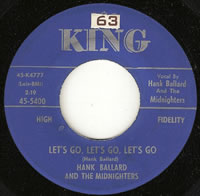
"Billy" Davis was a flamboyant figure on stage. He could do a back-over flip and would play his guitar with his teeth during a show. Davis was considered an actual "Midnighter" alongside the singers, and not just a member of the backing band, because of his ability to play and do the group's dance routines simutaneously.
Davis had first met the teenaged Jimi Hendrix in Seattle in 1959, and became a mentor to the future guitar legend. In an interview with Kent Alexander in the Metrotimes, Davis said "I used to take my Strat and we'd mess around. He didn't have an electric guitar at the time. He had a little acoustic. I used to go to his house and show him stuff and he just fell in love with it".
The rash of charting hits for Hank Ballard & The Midnighters continued for two more years and included; “The Hoochi Coochi Coo”, “Let’s Go Again (Where We Went Last Night)”, “The Continental Walk”, “The Switch-A-Roo”, “The Float”, “Nothing But Good”, and “Keep On Dancing”. But by 1962, the string of hits for the group had finally come to an end.
By the mid-1960’s, Ballard had broke up the group and branched out on his own. He retained the rights to the name Hank Ballard & The Midnighters, however, and reactivated the group with new members in later years. Because of the popularity of the British Invasion, Ballard’s popularity had dwindled and he began playing smaller clubs. He later joined the James Brown Revue and had a R&B hit in 1968 with “How You Gonna Get Respect (When You Haven’t Cut Your Process Yet)”.
Ballard continued to perform and record in the 70’s. He had a minor R&B hit in 1972 with “From The Love Side”, and he got some publicity in 1974 for his song “Let’s Go Streaking” which he reportedly recorded in the nude. Like many American R&B stars, Ballard remained very popular in England and Europe even as his fortunes declined at home, and he toured there extensively during the decade.
In the 1980’s Hank married Theresa McNeil who became his manager. McNeil helped polish up Ballard’s image and started him on the comeback trail. In the mid-1980’s he put together and sang with two new groups of Midnighters, one of which was all-female. In 1987, Hank recorded a new live double album, “Hank Ballard Live At The Palais”.
Ballard received a terrible blow in 1990 when his wife was killed in a hit-and-run accident. He never fully recovered from her loss. After a long and rewarding career, Hank Ballard passed away in 2003 at his home in Los Angeles from throat cancer. With him at the time of his death was his friend and caretaker Anna Ayala who was quoted in the Courier-Mail as saying “He was just a very good man and loved by many people”.
J. C. "Billy" Davis is still playing guitar at small blues clubs and festivals in Michigan. He has recorded several solo albums for No Cover Productions, a tiny blues label operating out of Clawson, Michigan.
Hank Ballard’s great contributions to music were acknowledged in 1990 when he was inducted into the Rock and Roll Hall of Fame. Further recognition for Hank Ballard & The Midnighters came in 2001 when they were inducted into the Doo-Wop Hall of Fame, and in 2010 when the group was voted into Michigan Rock and Roll Legends Hall of Fame. 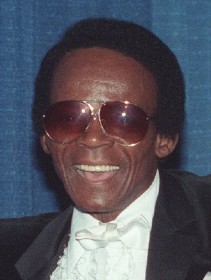 Hank Ballard
Hank Ballard
The Midnighters, who had not been included with Hank Ballard in his 1990 induction into the Rock and Roll Hall of Fame, got their due in 2012 when they were finally inducted. Their inclusion was the result of a special committee whose task was to identify situations in which groups should be recognized along with the original lead singer.
In a 1996 interview posted on the Real Blues website, Hank Ballard provided this memorable quote: “There’s no medicine out there as great as music. Music has been more therapeutic than holistic medicine. There’s something about music that’s just therapeutic. If you’re looking for youth, you’re looking for longetivity, just take a dose of Rock ‘n’ Roll”.
MRRL Hall of Fame: https://www.michiganrockandrolllegends.com/mrrl-hall-of-fame
Video: Listen to Hank Ballard & The Midnighters' 1960 hit "Finger Poppin' Time" https://www.youtube.com/watch?v=ZNi2gY7nzTU
Dr. J. Recommends: “Sexy Ways: The Best Of Hank Ballard & The Midnighters. Rhino 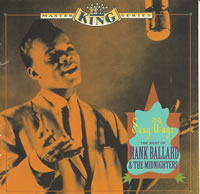 Records CD 1993. Although it is missing a few classic tunes, this is a fine collection that has all the biggest hits among its 20 selections.
Records CD 1993. Although it is missing a few classic tunes, this is a fine collection that has all the biggest hits among its 20 selections.
